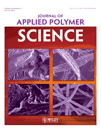Synthesis and characterization of poly(2-hydroxyethyl methacrylate)-functionalized Fe-Au/core-shell nanoparticles
Abstract
Disulfide-bearing poly(2-hydroxyethyl methacrylate) (DT-PHEMA) was synthesized by atom transfer radical polymerization technique, which was subsequently immobilized onto core-shell structured Fe-Au nanoparticles (Fe-AuNPs) by applying a “grafting to” protocol to afford new PHEMA-grafted Fe-AuNPs (PHEMA-g-Fe-AuNPs). The Fe-AuNPs having the iron core of 20–22 nm and the gold layer of 1–2 nm were initially prepared by inverse micelle technique and characterized by XRD and high-resolution transmission electron microscopy (HR-TEM). The grafting of DT-PHEMA on the Fe-AuNPs was confirmed by Fourier transformed infrared spectrophotometer, thermogravimetric (TGA), X-ray photoelectron spectroscopy, and energy dispersive X-ray analyses. The average diameter of polymer coated Fe-AuNPs was determined to be 28 nm by HR-TEM analysis. The amount of the polymer on the surface of Fe-AuNPs was calculated to be about 50% by TGA analysis. The studies of magnetic property by the superconducting quantum interference devices indicate the superparamagnetic property of Fe-AuNPs and PHEMA-g-Fe-AuNPs. The optical property of the PHEMA-g-Fe-AuNPs was recorded by UV–visible absorption spectroscopy, and a redshift in the absorption was observed, which further suggests the PHEMA attachment on the surface of Fe-AuNPs. The magnetic nanocomposites demonstrate good dispersibility in common polar solvents. © 2011 Wiley Periodicals, Inc. J Appl Polym Sci, 2011




